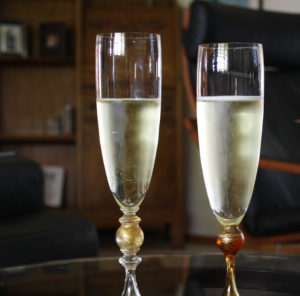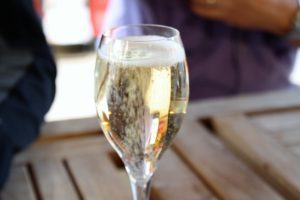Champagne

Not all bubbly is created equal, so while “champagne” is often used as a general term to describe all sparkling wine, true Champagne can only come from the small northern region of Champagne, France. world of sparkling wine.
GRAPES OF CHAMPAGNE
Historically, Champagne has been characterized by the fact that is blended in every sense: a blend of grapes, a blend of vintages and a blend of regions. While this is now not always the case, it is true that each of the three major grapes of Champagne contributes its own attributes to a wine.
Chardonnay
As the only major white grape in Champagne, Chardonnay has quite the category to represent, and represent it does. It contributes elegance, ageability and bright citrus flavors to Champagne blends. As 100 percent Chardonnay, this is called blanc de blanc.

Pinot Noir
Because Champagne is such a cold region, Pinot Noir needs to be planted in areas that allow it to ripen fully. Champagnes with a lot of Pinot Noir can be fairly broad and in your face.
Pinot Meunier
Pinot Meunier (also simply known as Meunier) is known for its aromatics and approachable fruit, acting as a bit of flavor-packed seasoning in Champagne blends. While formerly a rarity, some producers now specialize in 100 percent Pinot Meunier Champagnes.
Then there are the different types…
Blanc de Blancs
Blanc de blancs literally translates to “white from whites,” or Champagne made only from white grapes. Since Chardonnay is the only major white grape grown in Champagne, blanc de blancs wines are almost always 100 percent Chardonnay.
Blanc de Noirs
Blanc de noirs, or “white from black,” is the opposite of blanc de blancs. This is a white Champagne made from the red grapes Pinot Noir and Pinot Meunier (either blended together or from a single grape). Blanc de noirs Champagnes can have a silver or even rose-gold color, due to the slight skin contact.
Rosé Champagne
With the rise of the popularity of rosé has come the rise in popularity of rosé Champagne. Interestingly, Champagne is one of the only regions in the world where rosé may be made by blending red and white base wine. I like this one when done right.
You might wonder about dosage, a term you hear or read.
Dosage
Dosage is a mixture of sugar syrup and wine that is added to a Champagne right before permanently corking it for sale. While no- or low-dosage Champagnes are uber-trendy these days, the purpose of dosage is to balance acidity, so every Champagne needs something different. The wine is then labeled with a sweetness level, ranging from bone dry (Brut Nature and Extra Brut) to dry (Brut) to off-dry and sweet (Extra Dry, Sec, Demi-Sec, and Doux).